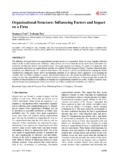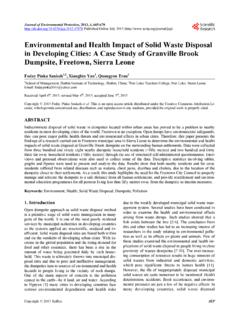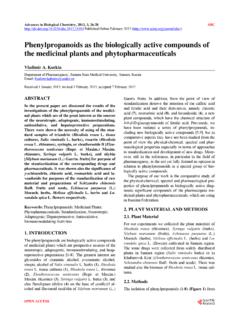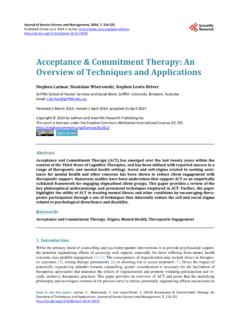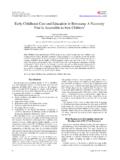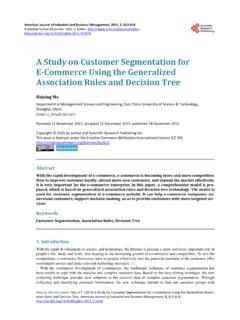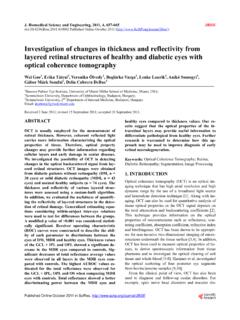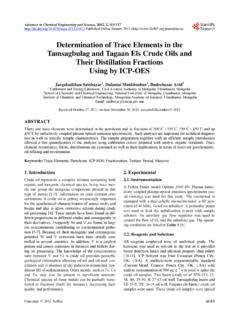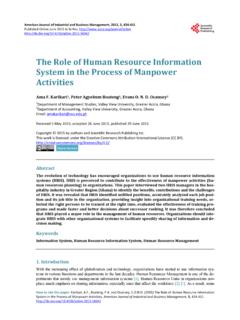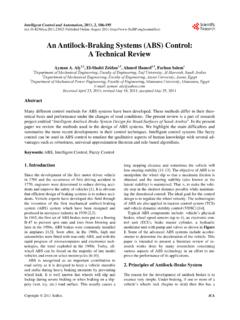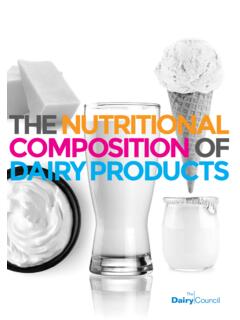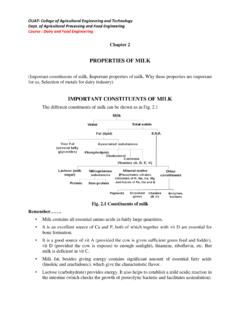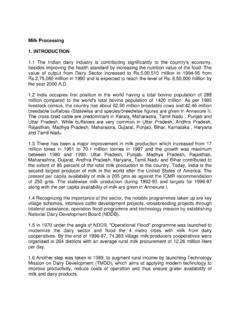Transcription of Milk Spoilage: Methods and Practices of Detecting Milk Quality
1 Food and Nutrition Sciences, 2013, 4, 113-123 Published Online July 2013 ( ) milk Spoilage: Methods and Practices of Detecting milk Quality Michael Lu, Yvonne Shiau, Jacklyn Wong, Raishay Lin, Hannah Kravis, Thomas Blackmon, Tanya Pakzad, Tiffany Jen, Amy Cheng, Jonathan Chang, Erin Ong, Nima Sarfaraz, Nam Sun Wang* Department of Chemical & Biomolecular Engineering, University of Maryland, College Park, USA. Email: Received March 28th, 2013; revised April 28th, 2013; accepted May 5th, 2013 Copyright 2013 Michael Lu et al. This is an open access article distributed under the Creative Commons Attribution License, which permits unrestricted use, distribution, and reproduction in any medium, provided the original work is properly cited.
2 ABSTRACT milk spoilage is an indefinite term and difficult to measure with accuracy. This uncertainty can cause suffering for both milk manufacturers and consumers. Consumers who have been misled by ambiguous expiration dates on milk cartons waste resources by disposing of unspoiled milk or experience discomfort from drinking spoiled milk . Consumers are often unwilling to purchase products close to their inaccurate expiration dates. This consumer behavior has a negative financial impact on milk producers. Inaccurate milk spoilage detection Methods also force milk producers to use overly conservative expiration dates in an effort to avoid the legal and economic consequences of consumers experiencing ill-ness from drinking spoiled milk .
3 Over the last decade, new Methods have been researched with the purpose of develop-ing more accurate and efficient means of Detecting milk spoilage. These Methods include indicators based on pH bacte-ria counts and gas-sensor arrays. This article explores various Methods of spoilage detection designed to prevent such consequences. The respective level of effectiveness of each method is discussed, as well as several further approaches to contain freshness regardless of detection. Keywords: milk Spoilage; Detection; pH; pH Detection; Methylene Blue Reduction; Amperometric Sensor; Magnetoelastic; Gas Sensor Array; Infrared Spectroscopy; Lipid/Fat Count 1.
4 Introduction Consumers currently determine milk spoilage by check- ing the sell by and best if used by dates on milk car- tons provided by suppliers. These dates are simple esti- mates of milk shelf life and are often inaccurate due to the variable processing, shipping, and storage conditions of the milk [1]. Retailers and consumers discard billions of pounds of unspoiled milk each year while relying on inaccurate printed expiration dates. Conversely, milk may spoil before the printed expiration, and spoiled milk can lead to food poisoning if consumed [2]. Another is- sue demonstrating the urgency of developing more accu- rate milk packaging is that unless there are local restric- tions for dairy products, the manufacturer determines the date; if an established regulation does not exist, manu- facturers can legally sell the expired product past the posted date.
5 The cities or processors that do have regula- tions have different sets of rules. For example, until 2010, milk could only be legally sold in New York City up to 96 hours after 6:00 AM on the day after pasteurization [3] [4]. Dairylea Cooperative, Inc., the biggest processor in the region, allows milk to be sold 10 to 12 days after pasteurization [5]. Researchers have recently begun investigating appli- cations of current technologies for the detection of milk spoilage. While the meat, fish, and fruit industries have continually advanced new Methods of packaging, pack- aging innovation in the milk packaging industry has re- mained stagnant [6].
6 Although a handful of packaging companies have proposed ideas for updated milk pack- aging designs, none of the proposed alternatives have succeeded in the market. Food industries and consumers have shown a trend of increasing interest in environmen- tally friendly, health-conscious intelligent packaging, and these market trends indicate the need to invest heavily in these novel developments [7]. Innovative milk packaging will further revolutionize the packaging industry and transform the way consumers think about packaging. The aims of this article are to review the current state of the intelligent food packaging industry and present an *Corresponding author.
7 Copyright 2013 SciRes. FNS milk Spoilage: Methods and Practices of Detecting milk Quality 114 update on the considerations that intelligent food pack- aging developers may contemplate for further advance- ment in this field. 2. Current Methods of milk Spoilage Detection Utilizing pH Indicators as a Measure of Spoilage Bacteria growth varies from one species of bacteria to another. While one bacteria species may prosper under certain conditions, another species may weaken. These conditions are interdependent and include nutrient avail- ability, moisture, oxygen levels and the level of other gases, the presence of inhibitors, temperature, and pH [8].
8 The pH of unspoiled milk is approximately , a level at which many forms of bacteria thrive [9]. At lower pH levels of - , lactic acid bacteria can grow and pro- duce lactic acid. While these organisms inhibit the growth of many pathogenic bacteria and are also inten- tionally employed to ferment milk to make other dairy products such as yogurt and cheese, they can also induce undesirable spoilage in certain products. Coliforms, a common form of bacteria, have been an indicator of the presence of pathogens in assessing the contamination of water as well as dairy products [10]. Coliforms can cause rapid spoilage in milk because they ferment lactose with the production of acid and gas, and they can also degrade milk proteins.
9 Escherichia coli is a well-known example of a coliform [11]. Studies have shown that other properties of milk also promote bacteria growth, such as the high availability of moisture and dissolved oxygen which supports both aerobic and facul- tative anaerobic microorganisms [12]. Temperature is frequently controlled to limit bacteria growth. Extreme heat is lethal to many organisms, such as coliforms, which explains the process of milk pasteurization (63 C for 30 minutes). Two types of bacteria exist in pasteur- ized milk : thermoduric bacteria, which are capable of surviving the extreme heat during pasteurization, and bacteria that originate from unsanitary conditions post- pasteurization [13].
10 Psychrotrophs comprise the largest percentage of bacteria in milk and cause spoilage in re- frigerator temperatures at or below 7 C [14]. Acidity increases as milk spoils; thus, acidity can be quantified to measure milk Quality . Acidity in dairy prod- ucts can be expressed in two ways: 1) titratable acidity, which shows total acidity but not acid strength; and 2) hydrogen ion concentration or pH, which indicates acid strength. The natural acidity of milk is - , and samples with higher figures indicate developed acid- ity [15]. At normal levels of pH, the main protein in milk , casein, remains evenly dispersed.
